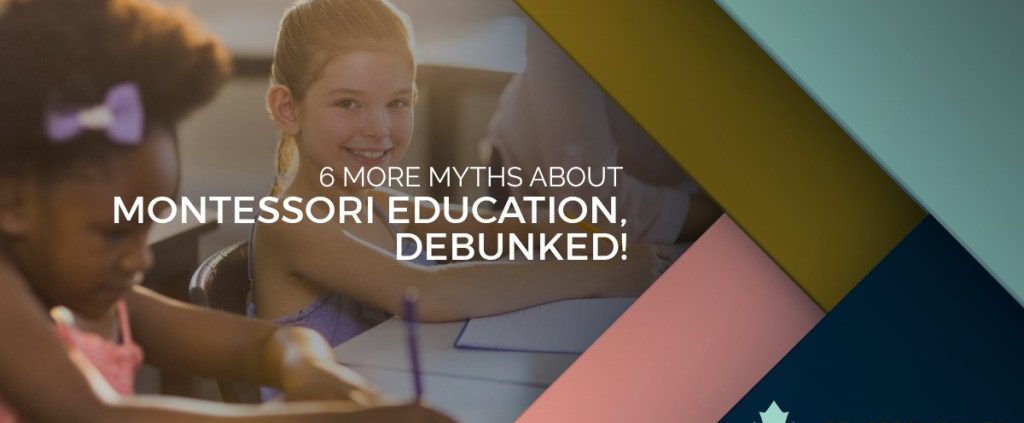What is it about Montessori that makes it so misunderstood? In our previous blog we took a look at seven of the biggest myths that surround this amazing type of early childhood education. First we discussed the seemingly-chaotic nature of a Montessori preschool and toddler classroom, and revealed the fact that children are learning as they play, while the teacher gently guides the children in ways that are specific to each child. Next we tackled the idea that Montessori is either religious or exclusionary to religion (it’s neither), and about how expensive it is (it’s really not that much more than typical daycare). In the end we put an end to the myth that Montessori school are just a passing fad, because they’ve been around for more than a century, with over 4500 in the United States alone.
Unfortunately, those aren’t the only myths that plague Montessori schools. Today we’re going to clear up few more misconceptions about this wonderful form of early childhood education.
Myth: Montessori is just for gifted children
Fact: We know exactly where this myth came from. Yes, children go through a Montessori program are often seen as gifted and more willing to learn…but that doesn’t mean they went in that way! Maria Montessori started her first school with low-income, typical Italian children, and she saw great strides in their learning.
Montessori is a wonderful method for teaching the gifted as well as those who might be a bit behind. In fact, the original model she used came from her time working with mentally disabled children, but she soon found that it worked with every kind of child. Our belief is that all children can learn, and that they simply need to find the style of learning that works best for them.
Myth: Montessori kids don’t transition to public school well
Fact: We teach infants, toddlers, and preschoolers at both our Eden Prairie and Golden Valley locations. Once a child reaches the preschool level, known as Primary in Montessori education, parents start to wonder if the children will be able to transition to a typical public school. The answer is “yes, certainly.”
First of all, since the kids have been in a social environment such as our academy, they won’t have any social problems associated with adapting to a traditional kindergarten. Second, Montessori preschools teach kids to adapt easily to changing situations without throwing a fit, something many other toddlers simply can’t handle. Montessori children are also excellent at meeting new people, because it’s something that we focus on.
Remember, this isn’t some sort of wacky new-age form of early childhood education. Children at a Montessori academy will learn to read and write while they’re with us, as well as be introduced to basic math and science principles. Children attending Montessori school will are taught the same things, just in a different way that is more in line with the way they learn.
Myth: Montessori isn’t rigorous
Fact: This is a complaint we usually hear about Montessori schools for older children, but we can address it because the myth survives. The fact is that it might not be rigorous in the same way traditional schools are, but it certainly gets students to the same place and beyond. A single objective might contain parts of math, science, and literature, instead of simply focusing on one of these subjects. This helps kids attack problems from multiple angles, allowing them to solve problems more creatively instead of teaching them to “keep hitting the problem until you punch through it” approach of traditional schools.
Myth: Montessori kids can do whatever they want
Fact: People might think that Montessori kids are allowed to do whatever they want, but that’s simply not true. While the kids at our academy certainly are given more freedom to develop their learning style, they are also given parameters. They’re certainly not allowed to walk all over the teachers.
Myth: Montessori is outdated
Fact: It’s actually traditional schools that are old-fashioned, because the public school model of teaching hasn’t changed much in nearly 200 years.
Montessori is constantly evolving and growing. That’s because those in our field are constantly aware of our roles in how children learn, with what works and what doesn’t. These learning styles are then shared online and among schools, and if they work then they are often implemented. Montessori schools are able to get better over time because we’re actively interested in making them better!
Myth: Mixed-age groups can cause problems.
Fact: In reality, mixed-age groups are one of the best parts of Montessori classrooms.
Our daycare rooms and classrooms have kids 6-weeks to 15 months (infants), 16 months to 33 months, and 33 months to six years. You’ll notice that preschool, aka Primary,encompassess children under three to over six. While at first that might seem like too wide a gap, that’s not a problem in a Montessori facility. Young children look up to older kids, and the older kids are taught to help out with the younger ones. It might not sound accurate at first, but the truth is that it’s been tested for more than a 100 years and it really does work!
Montessori education has been around a long time, and over the last century there has been a lot of chance for misinformation to build up around it. We hope we’ve cleared up some misconceptions that you might have heard over the years. If Montessori sounds like a good idea for your child, be sure to contact us and we’d love to show you around.




Leave a Reply
Want to join the discussion?Feel free to contribute!